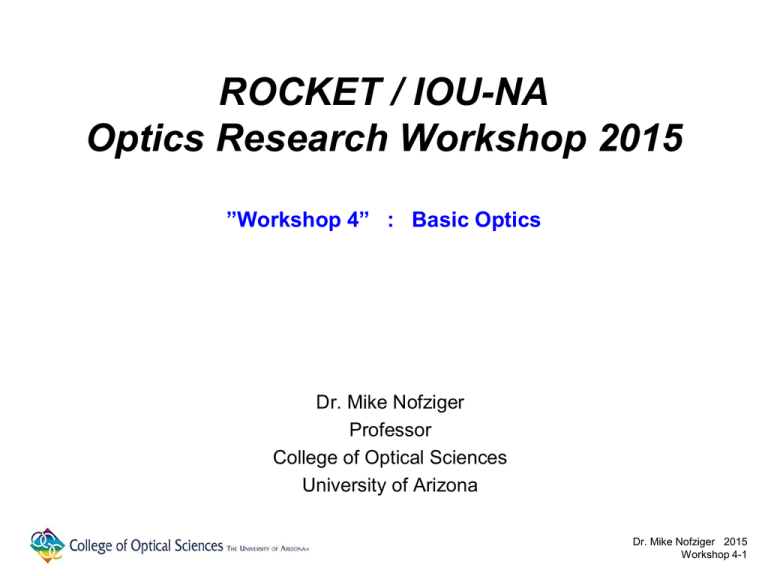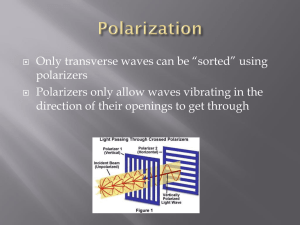Virtual Image - The University of Arizona College of Optical Sciences
advertisement

ROCKET / IOU-NA
Optics Research Workshop 2015
”Workshop 4” : Basic Optics
Dr. Mike Nofziger
Professor
College of Optical Sciences
University of Arizona
Dr. Mike Nofziger 2015
Workshop 4-1
Workshop #4 Outline:
● Reflection – The Law of Reflection
● Refraction – The Law of Refraction (Snell’s Law)
● Images
- Real vs. virtual
- Ghost images
- Sign conventions in optics
- Basic imaging equation
● Lenses
- Types of lenses
- How they form an image
- Examples
● Mirrors
- Types of mirrors
- How they form an image
- Examples
● Lab Exercises with Lenses and Mirrors
Dr. Mike Nofziger 2015
Workshop 4-2
Reflection:
Law of Reflection
The angle of reflection = the angle of incidence
θr = θi
Dr. Mike Nofziger 2015
Workshop 4-3
Virtual Image : The Flat Mirror – imaging properties.
● Each “critter” sees
- the same virtual image of the arrow, with the:
- same size (i.e. the same magnification).
- same location.
- same orientation.
● The virtual image is located behind the surface of the mirror
● The image distance = (-) the object distance.
Dr. Mike Nofziger 2015
Workshop 4-4
Virtual Image : The Kaleidoscope
- uses flat mirrors
- typically uses 3 mirrors
- held 60° apart
(equilateral triangle)
_______________________
- Looking through the
kaleidoscope, you see the
object directly, as 1/6 of
the image.
- Multiple virtual images of the
object produce the rest of
the image.
- Hexagonal, “6-fold” symmetry
Dr. Mike Nofziger 2015
Workshop 4-5
Virtual Image : The Rear View Mirror
- Flat surfaces, wedge in the glass
- Back surface is silvered (R ≈ 96%)
- Front surface is bare glass (R ≈ 4%)
- In day-time use, you adjust the mirror to see the (bright) reflection
from the back surface.
- In night-time use, you flip the tilt lever, to see the (dim) reflection
from the front surface.
Dr. Mike Nofziger 2015
Workshop 4-6
Reflection : Prisms
- Equilateral prism (dispersion)
- Corner Cube (retro-reflection)
- Porro prism pair
- Right angle prism (deviation)
Dr. Mike Nofziger 2015
Workshop 4-7
Refraction:
Law of Refraction
Snell’s Law
“Qualitative Understanding”
The Law of Refraction
(Snell's Law)
Light going from fast medium to slow bends
toward the normal.
Light going from slow medium to fast bends
away from the normal.
Dr. Mike Nofziger 2015
Workshop 4-8
Refraction:
Some Numbers:
v (vacuum) ≡ c = v (air) = 300,000,000 m/s
v (water) ≈ 225,000,562 m/s
v (glass) ≈ 197,368,421 m/s
..........but these are awkward to work with.
So, we refer the actual velocity in some material to c, as a ratio:
Index of Refraction ≡ n = c/v
..........(unitless, small, easy to work with)
n (air)
≈
n (ice)
≈
n (water)
≈
n (glass)
≈
n (cubic zirconia) ≈
n (diamond)
≈
1.0003
1.309
1.333
1.52
2.21
2.4
Dr. Mike Nofziger 2015
Workshop 4-9
Refraction:
Law of Refraction
Snell’s Law
“Mathematical Form”
Qualitative:
Light going from small n to large n
is bent toward the normal.
(air to glass)
Light going from large n to small n
is bent away from the normal.
(glass to air)
Mathematical:
ni sinθi = nt sinθt
Dr. Mike Nofziger 2015
Workshop 4-10
Images:
● Two fundamental types of images:
- Real Image ≡ An image that can be projected onto a surface.
(onto a screen, a white card, the wall, etc.)
Examples of real images :
- the image formed on the screen in a movie theater
- the image formed on the wall from a digital computer projector
- the image formed on the CCD sensor in a camera
- the image formed on the retina at the back of your eye
- Virtual Image : An image that appears to be located at a specific
location in space, but cannot be projected onto a surface.
(image seen in a flat mirror, through a magnifier, an eyepiece, etc.)
Examples of virtual images :
- the image seen looking into a flat mirror
(bathroom mirror, car rear-view mirror, kaleidoscopes)
- the image seen in a convex mirror
(garden “gazing ball”, car passenger-side mirror)
Dr. Mike Nofziger 2015
Workshop 4-11
● A ghost image is a faint, “secondary” image that appears from light
reflected from a bare glass surface:
(NOT the same as the after-image seen in many optical illusions)
- 4% of an incident beam of light is reflected from bare glass
(at normal incidence. The reflectance ↑ as the angle ↑)
- Ghost images show up in mirrors that have their “shiny” reflective
coating on the back surface (“second-surface” mirrors):
- bathroom and household mirrors
- Almost always, a ghost image is an unwanted image…
(especially in optical systems)
- Typically a ghost image is not even noticed, because it is so faint.
- Get rid of (avoid) ghost images by putting the “shiny” reflective
coating on the front surface of a mirror
(“front-surface” mirrors used in laser labs, telescopes, etc.)
Dr. Mike Nofziger 2015
Workshop 4-12
● “How to find ghost images”…..
(INSERT JOKE HERE about calling Ghost-Busters)
- Hold the tip of a pencil, pen, etc. up close to the mirror surface.
- Notice the ‘bright’ image of the pencil tip.
- Notice the ‘much fainter’ image of the pencil tip…
… displaced from the bright image
… displacement depends on how thick the mirror is!
- You can also notice 2 ghost images looking into a clear window…??!!
- Both are “equally faint”
- Both are never noticed in daily looking through windows
Dr. Mike Nofziger 2015
Workshop 4-13
● Ghost images in the Hubble Space Telescope!
The 2 faint “rings” of light are (unwanted!) ghost images, “caused by
reflection off the CCD and return reflections from the CCD housing
entrance window.”
Hubble Space Telescope Anomalies
Dr. Mike Nofziger 2015
Workshop 4-14
“Image Math”:
● Sign Conventions in optics: (a ‘can of worms’….)
Light travels from left to right.
You view the object and image by looking back towards the light source.
Mirrors
Lenses
●
●
●
●
●
●
f is negative for a concave mirror.
f is positive for a convex mirror.
xo is positive if the object lies to the left of the mirror.
xo is negative if the object lies to the right of the mirror.
xi is positive if the image lies to the left of the mirror.
xi is negative if the image lies to the right of the mirror.
●
●
●
●
●
●
f is positive for a positive (converging) lens.
f is negative for a negative (diverging) lens.
xo is positive if the object lies to the left of the lens.
xo is negative if the object lies to the right of the lens.
xi is positive if the image lies to the right of the lens.
xi is negative if the image lies to the left of the lens.
Dr. Mike Nofziger 2015
Workshop 4-15
“Image Math”:
● Two simple equations describe the properties of an optical imaging
system (applies to lenses, mirrors, lenses and mirrors):
- where the image is located
1 1 1
xo xi
f
1 1 1
xo xi
f
(use for mirrors)
(use for lenses)
- the size of the image (Magnification)
m
si
x
( ) i
so
xo
Dr. Mike Nofziger 2015
Workshop 4-16
Positive Lenses:
A converging lens, consisting of two converging surfaces.
(a) Rays parallel to the axis are focused at F'.
(b) Rays originating at F are also made to converge and emerge parallel to the axis.
F' is called the second focal point. F is called the first focal point.
Dr. Mike Nofziger 2015
Workshop 4-17
Negative Lenses:
A diverging lens, consisting of two diverging surfaces.
(a) Rays parallel to the axis seem to come from F' after they pass through the lens.
(b) Rays converging toward F are also made to diverge and emerge parallel to the axis.
F' is called the second focal point. F is called the first focal point.
Dr. Mike Nofziger 2015
Workshop 4-18
Power of a Lens:
The power of a lens is equal to the inverse of the focal length:
Power (in diopters, D) = P ≡ 1 / focal length (in meters)
● Short focal length lenses have relatively high power and bring rays to focus quickly.
● Long focal length lenses have relatively low power and bring rays to focus slowly.
● "The power of a lens measures the everyday notion of the 'strength' of a lens."
Example: The power of the human eye is about 60D (a very powerful lens!)
P = 60D = 1/ FL
FL = 16 mm = .016 meters
This is a very short focal length lens.
Example: The focal length of a typical hand-held magnifying glass is about 200mm.
FL = 200 mm = .2 meters
P = 1/ FL = 1/ .2 = 5D
This is a relatively low power lens.
Dr. Mike Nofziger 2015
Workshop 4-19
Mirrors:
Concave mirror ≡ "a mirror that bulges away from the source of light"
('caves in').
● The center of curvature, C, lies in front of the mirror.
● The focal point, F, lies in front of the mirror.
● The focal length, f, is negative.
● A concave mirror can produce either a real or a virtual image.
● The magnification m <1 , m =1, or m > 1.
Convex mirror ≡ "a mirror that bulges toward the source of light“
● The center of curvature, C, lies behind the mirror.
● The focal point, F, lies behind the mirror.
● The focal length, f, is positive
● A convex mirror always produces a virtual image.
● The magnification m < 1.
The focal length is 1/2 the radius of curvature: f = R/2
Dr. Mike Nofziger 2015
Workshop 4-20






